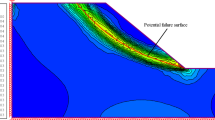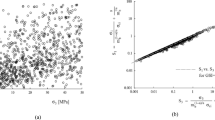Summary.
Most currently used techniques for analysing the stability of near surface structures, such as rock slopes, are based on the application of the effective Coulomb shear strength parameters cohesion c′, and the angle of friction φ′ on some known or anticipated shear surface subjected to an effective normal stress σ′ n . The most widely used of these techniques are the variants of the method of slices and related upper bound techniques. If the Hoek-Brown criterion is to be used to model the strength of near surface fractured rocks, it is necessary to determine equivalent Coulomb shear strength parameters for the specified level of effective normal stress. Calculation of the equivalent Coulomb parameters for the Hoek-Brown criterion for cases when a ≠ 0.5 is not a straightforward matter. A simple procedure for calculating instantaneous values of c′ i and φ′ i has been developed based on spreadsheet calculations and the application of a numerical optimisation routine. This procedure can also be applied to calculating the Hoek-Brown envelope plotted in shear stress/normal stress space. A simple closed form solution for c′ i and tan φ′ i has also been developed for the special case when a = 1. A three-dimensional version of the Hoek-Brown criterion has been developed by combining it with the Drucker-Prager criterion. This new yield criterion has been implemented by numerical solution of the governing equations. A simplification of this three-dimensional yield criterion has been developed by introducing an intermediate principal stress weighting factor. Comparison with published results demonstrates that this simplified criterion has the capacity to model the results of true triaxial tests for a range of different rock types over a wide range of stress levels. The new three-dimensional yield criterion has the advantage that its input parameters can be determined from routine uniaxial compression tests and mineralogical examination.
Similar content being viewed by others
References
G. Balmer (1952) ArticleTitleA general analytical solution for Mohr’s envelope. Am. Soc. Test. Mat. 52 1269–1271
L. B. Colmenares M. D. Zoback (2002) ArticleTitleA statistical evaluation of intact rock failure criteria constrained by polyaxial test data for five different rocks. Int. J. Rock Mech. Min. Sci. Geomech. Abstr. 39 IssueID6 695–729
Fjaer, E., Holt, R. M., Horsrud, P. A. M., Raaen, A. M., Risnes, R. (1992): Petroleum related rock mechanics. Elsevier, Amsterdam, 338 pp.
E. Hoek E. T. Brown (1997) ArticleTitlePractical estimates of rock mass strength. Int. J. Rock Mech. Min. Sci. Geomech. Abstr. 34 IssueID8 1165–1186 Occurrence Handle10.1016/S0148-9062(97)00305-7
Hoek, E., Carranza-Torres, C., Corkum, B. (2002): Hoek-Brown failure criterion – 2002 version Rocscience, http://www.rockscience.com/roc/software/software.asp.
Paterson, M. S. (1978): Experimental rock deformation – the brittle field. Springer-Verlag, Berlin Heidelberg New York Tokyo
PISA (2003): http://www.pisa.ab.ca/program/model/plastic/plastic.htm.
S. D. Priest E. T. Brown (1983) ArticleTitleProbabilistic stability analysis of variable rock slopes. Trans. Inst. Min. Metall. 92 A1–A12
Author information
Authors and Affiliations
Rights and permissions
About this article
Cite this article
Priest, S. Determination of Shear Strength and Three-dimensional Yield Strength for the Hoek-Brown Criterion. Rock Mech. Rock Engng. 38, 299–327 (2005). https://doi.org/10.1007/s00603-005-0056-5
Received:
Accepted:
Published:
Issue Date:
DOI: https://doi.org/10.1007/s00603-005-0056-5




